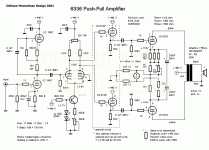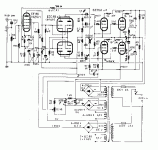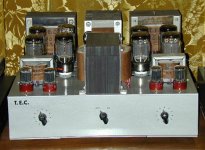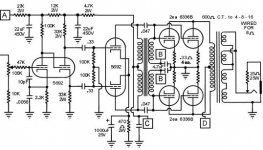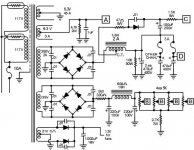As Tim mentions they're like a super beefy dual 6AS7/6080 with a 60W (2x30) plate dissipation. Don't seem very linear, but would work in OTLs, SRPP (incl parafeeds) or as pass/shunt elements in active power supplies.
However, they're not worth much. I got a half dozen NIB for less than a couple of pizzas. Prices on ebay are pretty low at the moment too.
What you do with them depends on what you want to accomplish doesn't it? Could be used in a highish power amp, but low impedance OPTs are less common as are higher current PS chokes. Try them and see what you think. The SRPP in particular is easy and may be able to use OPTs from other amps.
RCA datasheet
Raytheon datasheet
However, they're not worth much. I got a half dozen NIB for less than a couple of pizzas. Prices on ebay are pretty low at the moment too.
What you do with them depends on what you want to accomplish doesn't it? Could be used in a highish power amp, but low impedance OPTs are less common as are higher current PS chokes. Try them and see what you think. The SRPP in particular is easy and may be able to use OPTs from other amps.
RCA datasheet
Raytheon datasheet
Sooper Dooper SRPP
Hello ,
6336 would make an excellent stacked SRPP/SEPP (parafeed) output stage Use 1st tube in fixed bias for the lower amplifying stage , use 2nd tube as upper SRPP elements floating the filament to 1/2 B+ . This should make a good sounding output stage , use something like a 20uF parafeed cap and 600/8 ohm output transformer (a 230:12/12 mains toroid would work well for experimenting) . Only trouble with these things is that they're greedy buggers with the filament supply (6.3V 5A) . Have fun !
Use 1st tube in fixed bias for the lower amplifying stage , use 2nd tube as upper SRPP elements floating the filament to 1/2 B+ . This should make a good sounding output stage , use something like a 20uF parafeed cap and 600/8 ohm output transformer (a 230:12/12 mains toroid would work well for experimenting) . Only trouble with these things is that they're greedy buggers with the filament supply (6.3V 5A) . Have fun !
316a
exurbia said:I have 6x 6336A valves brand spanking new with special coolers
does anyone have a suggestion as to how i can use them or
should i sell them ? .
thanx in advance
Hello ,
6336 would make an excellent stacked SRPP/SEPP (parafeed) output stage
316a
> I have 6x 6336A valves brand spanking new with special coolers... does anyone have a suggestion as to how i can use them
I've been looking at these for 30 years. As far as I can tell, they are low-gain power-pigs.
Good mostly for the original purpose: massive regulators.
As audio tubes, the cathodes are too big (power hungry) for the output, and the gain is WAY low (Mu=2).
The heavy cathodes mean this is more of a heater than an amplifier.
The low Mu means that you can not build a practical quasi-efficient Audio Amplifier with 6336 unless you use an additional power supply for the driver.
Working at 250V B+, fixed-bias, the peak grid voltage is over 80 volts. So the driver probably needs over 400 volts B+ to run clean.
Fixed-bias is not a good idea on low-Mu triodes working at their ratings: small shifts in the tube can mean large shifts in bias and thus a melt-down. It actually seems to work if you run a 400V B+ and let 100-150 volts drop in a cathode bias resistor. But that means 33% of your power is wasted in the one resistor.
It roughs-out like: 60 watts in two plates, 30 watts in the cathode resistor, 30 watts in the heater == 120 watts of heat pouring out of the chassis, for maybe 20 to 30 watts of audio power.
Working at fairly high plate voltage and high load impedance (much higher than plate resistance) they would be fairly clean and linear. Except the enormous drive voltage often means more distortion in the driver than the output. You may need a quite beefy triode and a high driver supply voltage to get clean grid swings.
Also note that the 6336 grids are leaky, you need a fairly low grid resistor. Specs vary, but unless you have early (1958) TungSol the grid resistor should be 47K per tube. If you parallel a few 6336 to improve the power, the grids may need something like a small guitar amp power stage to whomp them around.
I'm sure it can be done. I may try it some day. Some COLD day when I need the heat.
I've been looking at these for 30 years. As far as I can tell, they are low-gain power-pigs.
Good mostly for the original purpose: massive regulators.
As audio tubes, the cathodes are too big (power hungry) for the output, and the gain is WAY low (Mu=2).
The heavy cathodes mean this is more of a heater than an amplifier.
The low Mu means that you can not build a practical quasi-efficient Audio Amplifier with 6336 unless you use an additional power supply for the driver.
Working at 250V B+, fixed-bias, the peak grid voltage is over 80 volts. So the driver probably needs over 400 volts B+ to run clean.
Fixed-bias is not a good idea on low-Mu triodes working at their ratings: small shifts in the tube can mean large shifts in bias and thus a melt-down. It actually seems to work if you run a 400V B+ and let 100-150 volts drop in a cathode bias resistor. But that means 33% of your power is wasted in the one resistor.
It roughs-out like: 60 watts in two plates, 30 watts in the cathode resistor, 30 watts in the heater == 120 watts of heat pouring out of the chassis, for maybe 20 to 30 watts of audio power.
Working at fairly high plate voltage and high load impedance (much higher than plate resistance) they would be fairly clean and linear. Except the enormous drive voltage often means more distortion in the driver than the output. You may need a quite beefy triode and a high driver supply voltage to get clean grid swings.
Also note that the 6336 grids are leaky, you need a fairly low grid resistor. Specs vary, but unless you have early (1958) TungSol the grid resistor should be 47K per tube. If you parallel a few 6336 to improve the power, the grids may need something like a small guitar amp power stage to whomp them around.
I'm sure it can be done. I may try it some day. Some COLD day when I need the heat.
not sure I agree entirely...
6336's getting rare and expensive. V-reg application lends specific characteristics (low-mu, high current) eminently suitable for OTL use. PP also possible - see attached circuit by De Haan which looks pretty good to me.
Personally I'm thinking of a hybrid single-ended darlington: 6336 into MJ11015 with current-source load.
6336's getting rare and expensive. V-reg application lends specific characteristics (low-mu, high current) eminently suitable for OTL use. PP also possible - see attached circuit by De Haan which looks pretty good to me.
Personally I'm thinking of a hybrid single-ended darlington: 6336 into MJ11015 with current-source load.
Attachments
> see attached circuit by De Haan which looks pretty good to me.
Looks fine to me. Is fairly inefficient: 70W B+ and 30W heater == 100 watts in for a claimed 17 watts out. The 17 Watts out looks about right for 8K load and low distortion. With a 4K load it could make 35-40 gross watts at clipping, but distortion would be higher. Taking 100 watts in for 40 watts out, it does not look all that bad! Especially considering it includes heater power.
> OTL amp using four 6336A per channel
Assuming a 16Ω loudspeaker, eight triodes (four 6336), and assuming that you can jam the loadline into the "V" between the zero-bias line and the plate power limit: this gives 20 watts out for probably over 200 watts of heat. Also the driver tube is really working too hard to whomp those grids around, even though it is fed +490V.
The actual condition with 160V per tube suggests a 200Ω loadline per pair, or 50Ω for four bottles (eight triodes).
(Assuming it was designed to respect the 30W plate limit. Actually in speech/music it could swing far above the plate dissipation limit on peaks, and maybe even on 1KHz test tones. Sustained 16Hz might show a flickering red glow and eventual plate cracking.)
Witihin ratings, that gives about 16 watts per pair, 64 watts for the whole rig, IF you have a 50Ω speaker. In 16Ω it would be 21 watts, in 8Ω only 11 watts. Or you could stack a dozen bottles per channel and drive maybe 150 watts into 16Ω. However that's over 1,000 watts of heat rising off the bottles! (and your electric bill)
Ignoring the plate rating, it may make a whole lot more power, though with some doubt about tube longevity if you use that power a lot.
Looks fine to me. Is fairly inefficient: 70W B+ and 30W heater == 100 watts in for a claimed 17 watts out. The 17 Watts out looks about right for 8K load and low distortion. With a 4K load it could make 35-40 gross watts at clipping, but distortion would be higher. Taking 100 watts in for 40 watts out, it does not look all that bad! Especially considering it includes heater power.
> OTL amp using four 6336A per channel
Assuming a 16Ω loudspeaker, eight triodes (four 6336), and assuming that you can jam the loadline into the "V" between the zero-bias line and the plate power limit: this gives 20 watts out for probably over 200 watts of heat. Also the driver tube is really working too hard to whomp those grids around, even though it is fed +490V.
The actual condition with 160V per tube suggests a 200Ω loadline per pair, or 50Ω for four bottles (eight triodes).
(Assuming it was designed to respect the 30W plate limit. Actually in speech/music it could swing far above the plate dissipation limit on peaks, and maybe even on 1KHz test tones. Sustained 16Hz might show a flickering red glow and eventual plate cracking.)
Witihin ratings, that gives about 16 watts per pair, 64 watts for the whole rig, IF you have a 50Ω speaker. In 16Ω it would be 21 watts, in 8Ω only 11 watts. Or you could stack a dozen bottles per channel and drive maybe 150 watts into 16Ω. However that's over 1,000 watts of heat rising off the bottles! (and your electric bill)
Ignoring the plate rating, it may make a whole lot more power, though with some doubt about tube longevity if you use that power a lot.
An externally hosted image should be here but it was not working when we last tested it.
For audio, a more interesting tube might be 6528.
http://www.tube.be/6528.html
http://www.pentalaboratories.com/product.asp?pf_id=6528A&dept_id=1381
This is apparently a 6336 (same heater and plate ratings) but with Mu=9! The ideal Mu for a tube with driver running on the same supply is about 5: any less, and the driver can't swing the grid, any more and the perveance and thus the peak current drops. In this series of tube, when aiming for low distortion and high efficiency, the perveance is not so important and a Mu of 9 means easy driving.
In a 6336 circuit: reduce the bias and you don't need so much drive. It may work with 320 volts on the plate and only 25-30 volts bias and drive, a radical reduction from the 114 volts the 6336 needs in a similar situation. Power output is similar, unless 6336 output was limited by lack of drive, or you were wasting a ton of B+ in a bias resistor and can handle more tube-volt and plate swing.
They get the high Mu not by forcing plate resistance up, but by increasing transconductance (to 37,000 µMho!).
One disadvantage: the 6528 is a rare bird. It was apparently used only in one model of radio transmitter. And the Gm suggests it is not an easy tube to build. PentaLabs above lists it at $85, but uncertain availability ("Call").
http://www.tube.be/6528.html
http://www.pentalaboratories.com/product.asp?pf_id=6528A&dept_id=1381
This is apparently a 6336 (same heater and plate ratings) but with Mu=9! The ideal Mu for a tube with driver running on the same supply is about 5: any less, and the driver can't swing the grid, any more and the perveance and thus the peak current drops. In this series of tube, when aiming for low distortion and high efficiency, the perveance is not so important and a Mu of 9 means easy driving.
In a 6336 circuit: reduce the bias and you don't need so much drive. It may work with 320 volts on the plate and only 25-30 volts bias and drive, a radical reduction from the 114 volts the 6336 needs in a similar situation. Power output is similar, unless 6336 output was limited by lack of drive, or you were wasting a ton of B+ in a bias resistor and can handle more tube-volt and plate swing.
They get the high Mu not by forcing plate resistance up, but by increasing transconductance (to 37,000 µMho!).
One disadvantage: the 6528 is a rare bird. It was apparently used only in one model of radio transmitter. And the Gm suggests it is not an easy tube to build. PentaLabs above lists it at $85, but uncertain availability ("Call").
Re: your loadline: I'm sure you're well aware that an OTL is never ran in class A for efficiency reasons; AB is taken instead. The lower standing plate dissipation, as well as cutoff for part of the cycle, means instantaneous plate dissipation well over limit, but since it's the RMS that matters (within the plate's thermal mass' time constant), the tube will still be within ratings. So such a conservative and high speaker load is not necessary.
Tim
Tim
Hi,
Which is why I often say plot the circuit not the tube as such.
Lest we're talking a one of, lets forget about the 6528, even the 6336A and focus on what's available in quantity today and tomorrow.
The 6080, 6AS7G, 6C33C, 6C19P and such are all prime candidates.
And if you must really go esoteric on OTL tubes find me a set of 7241s...
BTW, the TAKI circuit posted above delivers 140W peak into a 16 Ohm load...
The driver isn't the greatest, I know. That can easily be solved...
I had 10 6336A driven by a pair of 6BX7s easy.
The problem is mainly Miller capacitance, once overcom you have all the BW you dreamt of.
Cheers,
Re: your loadline: I'm sure you're well aware that an OTL is never ran in class A for efficiency reasons; AB is taken instead.
Which is why I often say plot the circuit not the tube as such.
Lest we're talking a one of, lets forget about the 6528, even the 6336A and focus on what's available in quantity today and tomorrow.
The 6080, 6AS7G, 6C33C, 6C19P and such are all prime candidates.
And if you must really go esoteric on OTL tubes find me a set of 7241s...
BTW, the TAKI circuit posted above delivers 140W peak into a 16 Ohm load...
The driver isn't the greatest, I know. That can easily be solved...
I had 10 6336A driven by a pair of 6BX7s easy.
The problem is mainly Miller capacitance, once overcom you have all the BW you dreamt of.
Cheers,
Judging from PRR posted loadlines the 6336A is a considerably different animal than the 6336. The 6336A has an absolute max. plate voltage of 400v. A good operating point for it would be approx. -70 volts on the grid and 260v on the plate giving a quiescent current of about 105ma. With a plate load of ca. 3.2k, it could give about 6W of fairly low distortion power. The great thing about DIY design compared to designing commercial products is one doesn't have to worry about things like efficiency and cost effectiveness. If you have some tubes on hand, give them a go.
John
John
6336A
OOOWEEEEEE!!!!!!!!
thanks guys you are worth your weight in whatever
as i have 6 of the beasts and 40 odd amps of heater trafo
winter will be the only time they are used, without air con.
how about if i parallel three per side S.E and drive them with
either a trafo or an ht solid state driver .
any suggestions greatfully accepted, by the way i have a few
strange power tubes including 11e1 and vt104 TT
OOOWEEEEEE!!!!!!!!
thanks guys you are worth your weight in whatever
as i have 6 of the beasts and 40 odd amps of heater trafo
winter will be the only time they are used, without air con.
how about if i parallel three per side S.E and drive them with
either a trafo or an ht solid state driver .
any suggestions greatfully accepted, by the way i have a few
strange power tubes including 11e1 and vt104 TT
Hi,
Good of you to remind us...I had the A version in mind all along, the 6336 otherwise being rather useless for audio service.
Thanks,
Judging from PRR posted loadlines the 6336A is a considerably different animal than the 6336.
Good of you to remind us...I had the A version in mind all along, the 6336 otherwise being rather useless for audio service.
Thanks,
> Re: your loadline: I'm sure you're well aware that an OTL is never ran in class A
Those platelines are drawn for "pure B" operation. The flattest one is zero bias at 400V B+.
Or alternatively, they are (half) the Dynamic Loadline for two tubes taken together, ignoring the bias current which cancels before it gets to the load.
In Real Life, we would have to run Class A or Class AB, of course. The per-tube loadines would bend up at the right to intersect the bias point. But that has almost no effect on the maximum power output, only the cleanliness of part-power operation (and the drive voltage required).
> instantaneous plate dissipation well over limit
I was taught conservatively. Loadline should not cross the dissipation limit line. (Exception: hard-driven inverters with very fast rise times may often cross through the "forbidden zone", as long as you are sure they "can't" stall in that area.)
I've questioned this idea. Midrange audio is quick enough that the plate won't overheat significantly in a part-cycle. And for normal speech/music in near-B operation, peaks above the dissipation limit are extremely rare. However I have seen trouble (not well investigated) when exceeding the Pd line and doing full-power testing. Even though the plate as a whole will not overheat, small hot-spots can get into secondary emission and runaway problems.
And of course we are free to abuse our plates if we accept the loss of lifespan. The TAKI circuit that Frank posted apparently runs peak current 150% of rated DC current (OK, probably) and peak dissipation 200% of rated dissipation (OK, maybe, especially on speech/music and an understanding that the tubes may not live forever).
> The 6080, 6AS7G, 6C33C, 6C19P and such are all prime candidates.
6080/6AS7 are relatively small tubes, not good for large power. They would be fine for modest expectations, except with Mu of 2 or 3 they are a real pain to drive. 2A3/6B4 is a much easier tube to drive (it was made for audio), and prettier too.
6c33c is made by just one factory which could burn-down or convert to making KIA engines at any moment. It is also a very strange tube with severely bent characteristics. However it is available now at prices that allow experimentation. 6c19p is new to me. It looks a bit "small"; however I see you can get 200 watts from 48 of them. Which is not absurd because they are only $10 each.
I am not sure what difference you see between 6336 and 6336A.
NOS 6336 are available enough to use as transformer-out amps, and there is no great need nor advantage in taking them past their dissipation limits. The 400V B+ to 250mA loadline above is good for 40 watts, which is pretty good for one bottle.
For the massively-parallel OTL designs, I'd rather not see precious tubes (ones that will never be made again) abused.
Those platelines are drawn for "pure B" operation. The flattest one is zero bias at 400V B+.
Or alternatively, they are (half) the Dynamic Loadline for two tubes taken together, ignoring the bias current which cancels before it gets to the load.
In Real Life, we would have to run Class A or Class AB, of course. The per-tube loadines would bend up at the right to intersect the bias point. But that has almost no effect on the maximum power output, only the cleanliness of part-power operation (and the drive voltage required).
> instantaneous plate dissipation well over limit
I was taught conservatively. Loadline should not cross the dissipation limit line. (Exception: hard-driven inverters with very fast rise times may often cross through the "forbidden zone", as long as you are sure they "can't" stall in that area.)
I've questioned this idea. Midrange audio is quick enough that the plate won't overheat significantly in a part-cycle. And for normal speech/music in near-B operation, peaks above the dissipation limit are extremely rare. However I have seen trouble (not well investigated) when exceeding the Pd line and doing full-power testing. Even though the plate as a whole will not overheat, small hot-spots can get into secondary emission and runaway problems.
And of course we are free to abuse our plates if we accept the loss of lifespan. The TAKI circuit that Frank posted apparently runs peak current 150% of rated DC current (OK, probably) and peak dissipation 200% of rated dissipation (OK, maybe, especially on speech/music and an understanding that the tubes may not live forever).
> The 6080, 6AS7G, 6C33C, 6C19P and such are all prime candidates.
6080/6AS7 are relatively small tubes, not good for large power. They would be fine for modest expectations, except with Mu of 2 or 3 they are a real pain to drive. 2A3/6B4 is a much easier tube to drive (it was made for audio), and prettier too.
6c33c is made by just one factory which could burn-down or convert to making KIA engines at any moment. It is also a very strange tube with severely bent characteristics. However it is available now at prices that allow experimentation. 6c19p is new to me. It looks a bit "small"; however I see you can get 200 watts from 48 of them. Which is not absurd because they are only $10 each.
I am not sure what difference you see between 6336 and 6336A.
NOS 6336 are available enough to use as transformer-out amps, and there is no great need nor advantage in taking them past their dissipation limits. The 400V B+ to 250mA loadline above is good for 40 watts, which is pretty good for one bottle.
For the massively-parallel OTL designs, I'd rather not see precious tubes (ones that will never be made again) abused.
120 watts a channel 6336A amp
T.E.C. TRIODE AMPS
T.E.C. TRIODE AMPS
Attachments
You can try GM-5B (ГМ-5Б) which I believe is the same one.awesome low rp triode (almost eco)
3cx300a1-svetlana
hard to find thou
- Status
- This old topic is closed. If you want to reopen this topic, contact a moderator using the "Report Post" button.
- Home
- Amplifiers
- Tubes / Valves
- 6336A valves

